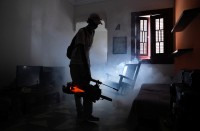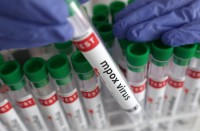(Reuters Health) – The ultraviolet lamps used in some nail salons to dry and cure nail polish deliver the same hazardous rays as tanning beds, but it would take many manicures to actually cause damage, suggests a new study.
After testing 17 different lamps in nail salons, researchers calculated that it would take between eight and 208 visits – depending on the machine – to damage skin cells in a way that raises cancer risk.
“I wouldn’t tell a patient to stop going unless they were going multiple times a month,” lead author Dr. Lyndsay Shipp from Georgia Regents University in Augusta told Reuters Health.
Exposure to ultraviolet (UV) radiation is a risk factor for most skin cancers, according to the American Cancer Society. Natural sunlight and UV lamps used for tanning give off the harmful rays, as do the small lamps used to speed drying in nail salons.
Previous studies have looked at the polish-drying UV lamps and suggested the rays may be powerful enough to cause damage, Shipp’s team notes in JAMA Dermatology, but those studies had flaws.
“They didn’t actually go out and measure the nail lamps themselves and measure the UV radiation they’re exposed to,” Shipp said.
For the new study, the researchers measured the UV-A rays produced by 17 different nail polish drying devices at 16 salons.
UV-A is one of three types of UV ray. It ages the skin to cause wrinkles and breaks DNA strands within skin cells, which can lead to cancer.
The lamps tested by the researchers differed in their power levels, but generally UV lamps with higher wattages put out higher levels of UV-A radiation.
Based on a calculation of how much UV-A radiation exposure is needed to damage DNA, the researchers found that it would take – on average – 11 uses for the devices to deliver enough UV-A to raise cancer risk.
They estimated that hands would be in the device for about eight minutes per manicure, and the risky total exposure times ranged from eight minutes to 208 minutes, depending on the machine.
Although the risk is low, Shipp’s team endorsed the idea of wearing sunscreen to protect hands from UV damage.
Dr. Alina Markova, who was not involved in the new study, told Reuters Health it’s also important to note that DNA damage doesn’t mean the person will develop cancer.
“Just one risk factor of DNA damage doesn’t mean you’ll have a clinical outcome of skin cancer or photoaging,” she said.
Markova, who works within the Boston University Department of Dermatology, has studied the UV rays put off by nail salon lamps.
“While we’re starting to realize these UV nail lamps are relatively safe, we still need to realize that the artificial UV devices that are hazardous are tanning beds,” she said.
The World Health Organization (WHO), the American Medical Association and the American Academy of Dermatology have come out against indoor tanning in recent years.
In 2009, WHO labeled tanning devices as high-level carcinogens, which puts tanning on par with tobacco use as a public health threat.
Shipp said doctors can’t say anything is perfectly safe, but nail salon lamps seem relatively safe.
“Personally, I won’t stop getting manicures myself,” she said.
SOURCE: bit.ly/WjBo5P JAMA Dermatology, online April 30, 2014.







